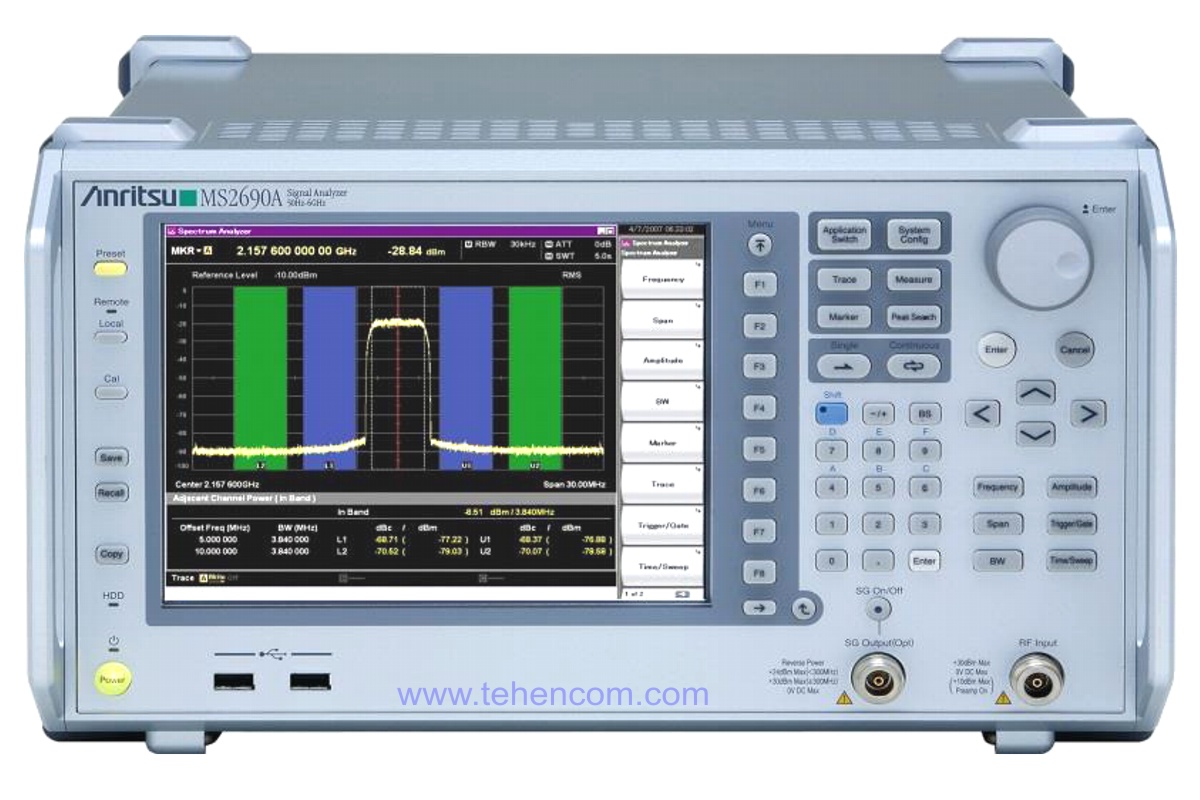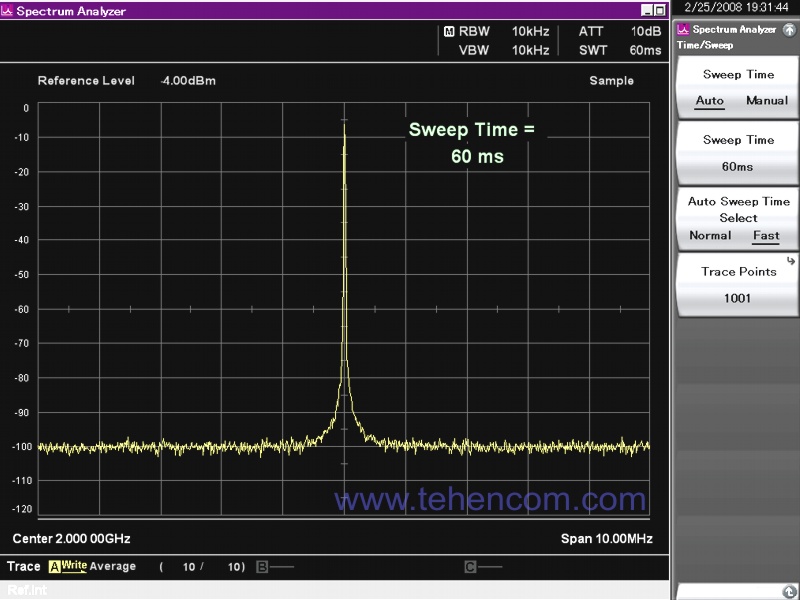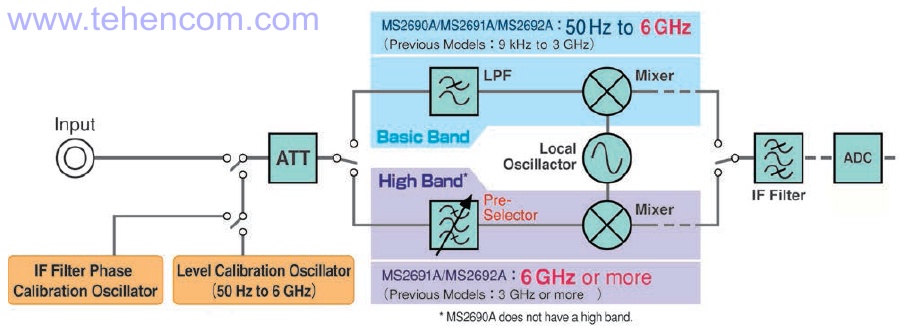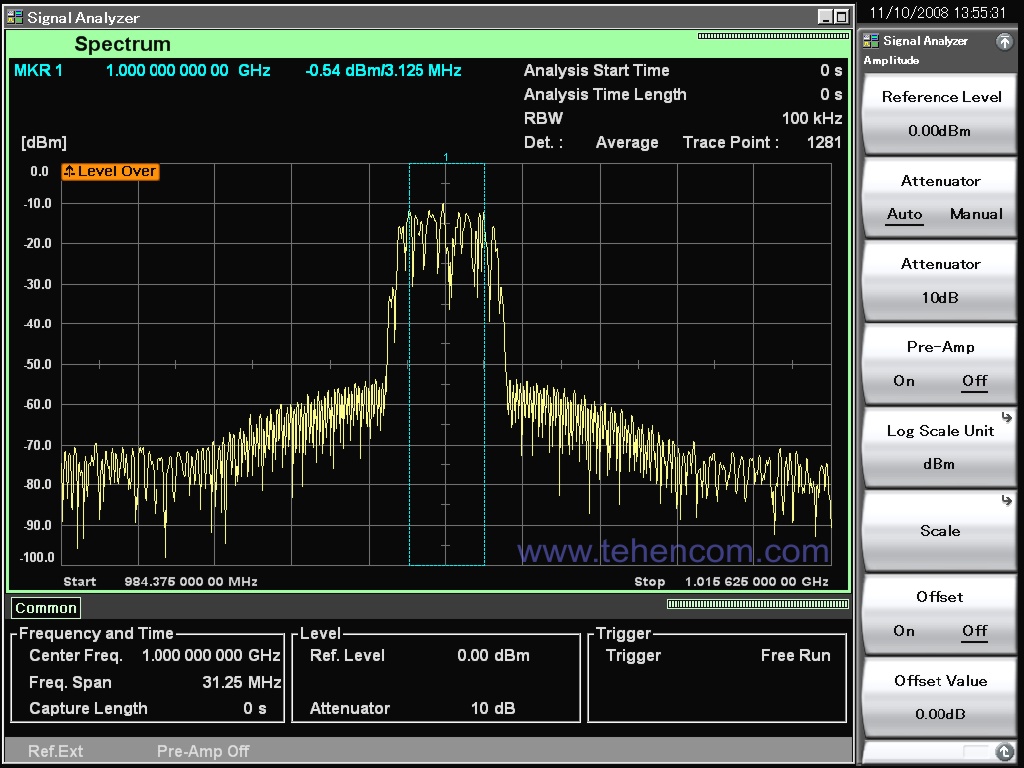Anritsu MS269xA series of spectrum and signal analyzers up to 26.5 GHz

Brief description of the series
Spectrum and signal analyzers Anritsu MS269xA Series provide maximum accuracy and speed of measurements, as well as a number of advanced features: built-in vector signal generator, etc. When developing the MS269xA series, a Japanese company Anritsu First of all, I tried to provide maximum technical characteristics. The series contains three models that differ in frequency range: MS2690A (50Hz - 6GHz), MS2691A (50Hz - 13.5GHz), MS2692A (50Hz - 26.5GHz).
You can download a full description of all the characteristics of Anritsu MS269xA below on this page in the section Documentation. And the main differences between the four series of Anritsu laboratory spectrum analyzers and signals, see in this comparison.
All models of the series
The Anritsu MS269xA series consists of three models, which are presented in this interactive table. To see all the characteristics of certain models, add them to the comparison.
| Model |
Maximum frequency
|
Minimum frequency
|
Signal analysis bandwidth
|
SSB phase noise
|
RF signal generation
|
Weight
|
|---|---|---|---|---|---|---|
|
MS2690A
|
6 GHz | 50 Hz | 31.25 MHz 62.5 MHz 125 MHz | -116 dBc/Hz | 125 MHz – 6 GHz | 13.5 kg |
|
Discontinued
Recommended replacement:
Anritsu MS2850A-047
MS2691A
|
13.5 GHz | 50 Hz | 31.25 MHz 62.5 MHz 125 MHz | -116 dBc/Hz | 125 MHz – 6 GHz | 13.5 kg |
|
Discontinued
Recommended replacement:
Anritsu MS2850A-047
MS2692A
|
26.5 GHz | 50 Hz | 31.25 MHz 62.5 MHz 125 MHz | -116 dBc/Hz | 125 MHz – 6 GHz | 13.5 kg |
Main features of the series
Frequency: 50 Hz – 6 GHz (model MS2690A).
Frequency: 50 Hz – 13.5 GHz (model MS2691A).
Frequency: 50 Hz – 26.5 GHz (model MS2692A).
Resolution (RBW): 1 Hz - 31.25 MHz.
Signal analysis bandwidth: 31.25 MHz (typical); 62.5 MHz (option); 125 MHz (option).
Amplitude: +30 dBm to -155 dBm. Amplitude error: ±0.3 dB.
Hardware options: preamplifier, rubidium reference oscillator, vector signal generator (125 MHz - 6 GHz), arbitrary waveform generator, BER measurement, noise figure (noise factor) measurement, preselector disable (bypass), direct digitization of the radio signal to an external disk.
Software Options: generation, demodulation and analysis of wireless communication standards: LTE, GSM/EDGE, W-CDMA/HSPA+, TD-SCDMA, CDMA2000, EV-DO, HSDPA/HSUPA, WiMAX, WLAN (802.11), Bluetooth and others (total 37 software options).
Screen 21.3 cm (resolution 1024 x 768). Interfaces: USB, Ethernet, IEEE-488 (GPIB).
Weight: 13.5 kg. Dimensions: 340 x 200 x 350 mm. Working temperature: from +5°С to +45°С.
Each of the MS2690A, MS2691A, and MS2692A instruments comes standard with spectrum analyzer and signal analyzer functionality. When installing an additional option, it is possible to add the functionality of a vector signal generator with an operating range from 125 MHz to 6 GHz. In this case, it will become possible not only to generate vector signals, but also to record signals from the air into the device's memory with subsequent generation of their exact copy.

In addition, Anritsu releases another series of laboratory spectrum and signal analyzers: MS2830A. This series is slightly simpler than the MS269xA in terms of technical characteristics, but provides a frequency range up to 43 GHz (and with external mixers up to 325 GHz) and a very large set of expansion options.
Need a quality analyzer in a portable case? Watch the series Anritsu MS2720T.
Need portable and up to 54 GHz? Watch the series Anritsu MS2090A Field Master Pro.
Need a laboratory analyzer, but cheaper? Watch the series Anritsu MS2830A.
Need minimal phase noise? Watch the series Anritsu MS2840A.
Need demodulation bandwidth up to 1 GHz? Watch the series Anritsu MS2850A.
Need real-time spectrum analyzer? Watch the series Tektronix RSA500A.
You need a spectrum analyzer combined with an oscilloscope? Watch the series Tektronix MDO4000C.
Want more information? Here you can Read and download all about spectrum analyzer.
Spectrum analyzer mode
Each of the MS2690A, MS2691A and MS2692A instruments comes standard with powerful functionality spectrum analyzer. Spectrum analyzer standard measurement list includes:
- channel power;
- occupied bandwidth;
- adjacent channel leakage power;
- spectrum emission mask;
- spurious emission;
- burst average power;
- frequency counter;
- multi-marker & marker list;
- highest 10 markers;
- limit lines;
- 2-tone 3rd-order intermodulation distortion;
- phase noise.
The Anritsu MS2690A, MS2691A and MS2692A spectrum analyzers are extremely accurate and fast. This is one of the company's best analyzer series. Anritsu. For example, the photo below shows the dynamic range and measurement speed of a real signal. For a complete list of instrument capabilities in spectrum analyzer mode, see this page in the section Documentation.

Signal analyzer mode
As standard, each of the MS2690A, MS2691A, and MS2692A also contains a first-class signal analyzer. The standard set of measurements that can be performed include:
- power vs. time;
- frequency vs. time;
- phase vs. time;
- CCDF/APD;
- AM depth;
- FM deviation;
- time-frequency diagram.
With additional software options, it is also possible to perform demodulation and analysis of wireless communication standards: LTE, GSM/EDGE, W-CDMA/HSPA+, TD-SCDMA, CDMA2000, EV-DO, HSDPA/HSUPA, WiMAX, WLAN (802.11), Bluetooth and others. For a complete list of instrument capabilities in signal analyzer mode, see below on this page in the section Documentation.

Vector signal generator mode
built-in vector signal generator (option -020 and additional software options) significantly expands the scope of the MS2690A, MS2691A and MS2692A instruments. In addition to generating standard signals: LTE, GSM/EDGE, W-CDMA/HSPA+, TD-SCDMA, CDMA2000, EV-DO, HSDPA/HSUPA, WiMAX, WLAN (802.11), Bluetooth and other types, you can also create your own types of any signals in the range of 125 MHz – 6 GHz. For example, add noise to the test signal (as in the photo below), to check the stability of the receiving equipment with a poor signal-to-noise ratio. For a complete list of instrument capabilities in vector signal generator mode, see below on this page in the section Documentation.

Improved operating principle
Many spectrum analyzer models are built so that their main operating range is 3 GHz, and all frequencies above 3 GHz are downsampled to this operating range using internal mixers. As a result, these analyzers provide maximum performance in the range up to 3 GHz.
On the other hand, the Anritsu MS2690A, MS2691A and MS2692A analyzers are based on a new, improved design. Their main operating frequency range is as much as 6 GHz. And in all this range the maximum accuracy of measurements is provided. Thanks to this technical solution, the Anritsu MS269xA series analyzers have the best performance in their class.

Large, clear display
The Anritsu MS269xA Series Spectrum and Signal Analyzers feature a high-quality 21.3 cm screen with a resolution of 1024 x 768. All basic analyzer settings are permanently displayed on the main screen, reducing the need to use additional menus. The spectrogram is also displayed very clearly and in detail.

Differences between Anritsu laboratory analyzers
Currently, the Japanese company Anritsu produces four series of laboratory spectrum and signal analyzers: Anritsu MS2830A, Anritsu MS2840A, Anritsu MS2850A and Anritsu MS269xA. All of them are made in a classic desktop case and have a unified user interface. However, these four series differ in terms of features (options), measurement accuracy and cost.

Series Anritsu MS2830A (up to 43 GHz) belongs to the middle class, both in terms of measurement accuracy and cost. It provides an excellent price/feature ratio and is well suited for a wide range of spectrum and signal analysis applications. It is worth emphasizing the excellent opportunities for working with commercial communication standards, for example: LTE, W-CDMA, GSM, WLAN, etc. (excluding 5G). The MS2830A Series instruments can analyze signals up to 125 MHz bandwidth, however, if the analysis bandwidth exceeds 31.25 MHz, then there must be no other signals outside the analyzed bandwidth, otherwise image frequencies will be generated.
Series Anritsu MS2840A (up to 44.5 GHz) has improved performance compared to the MS2830A, especially in terms of phase noise at small offsets from the carrier. Demodulation of commercial communication standards is not supported, but the MS2840A series is great for developing and configuring devices using proprietary digital modulations based on QAM, APSK, etc., as well as various analog modulations. Like the MS2830A Series, the MS2840A Series can analyze signals up to 125 MHz bandwidth, however, if the analysis bandwidth exceeds 31.25 MHz, then there must be no other signals outside the analysis bandwidth, otherwise image frequencies will be generated.
Series Anritsu MS2850A (up to 44.5 GHz) provides the same measurement accuracy as the MS2840A series, plus it can demodulate and analyze signals in a record-breaking 1 GHz bandwidth. This series is ideal for designing and customizing 5G equipment, as well as any devices that use wide modulation bandwidths, such as satellite communications systems or native broadband digital communications systems. Commercial standards (LTE, W-CDMA, GSM, etc.) are also supported. In addition, the MS2850A Series analyzers can record up to 3.9 GS/s of digitized signal to internal memory and transfer it to a computer for advanced analysis, while sampling rates can reach 1.3 GS/s, which allows you to analyze any signal in detail, including impulse.
Series Anritsu MS269xA (up to 26.5 GHz) belongs to the high class in terms of measurement accuracy, and costs a little more than the MS2840A series. The main feature of the MS269xA series is the ability to analyze signals with a bandwidth of up to 125 MHz without the appearance of mirror frequencies. Demodulation of commercial communication standards is supported: LTE, W-CDMA, GSM, WLAN, etc. 5G demodulation and analysis is also supported.
All series of Anritsu laboratory spectrum and signal analyzers can be equipped with a variety of additional options that solve various practical problems, for example: EMC preliminary tests, phase noise measurements, complex waveform generation with built-in vector generator, high-precision frequency measurements with built-in rubidium reference generator, etc. Please note that when using external mixers, the operating frequency range of some laboratory analyzers can be extended up to 325 GHz.
Documentation
This PDF documentation contains the most comprehensive description of Anritsu's MS269xA Series Analyzer features, specifications and modes of operation.
Description of analyzers Anritsu MS2690A, MS2691A, MS2692A (in English) (48 pages; 6 MB)
Description of signal analyzer software options (in English) (76 pages; 6 MB)
Embedded Vector Signal Generator Software Options Description (in English) (84 pages; 5 MB)
And here you can find our tips and other useful information on this topic:
Basic theory for spectrum analysis and signal analysis
How to buy equipment cheaper – discounts, special prices, demo and used devices
To simplify the process of choosing a spectrum and signal analyzer, you can use our experience and recommendations. We have over 20 years of practical supply experience and can immediately answer many questions about models, options, delivery times, prices and discounts. This will save your time and money. For this it's simple call us or write to us at E-mail and we will be happy to answer your questions.



